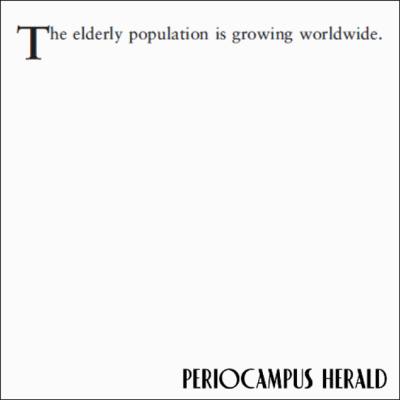A Periodontist’s Notebook - March 16, 2021
Take virtually any article on geriatric dentistry, or anything geriatric for that matter, and you will find them welcoming you with what seem like almost identical openings. The first sentence is most commonly a variation on "The global population is ageing". Epidemiological data is presented in a somewhat ominous tone. Warnings are given about the shortfalls of the healthcare system to address the demographic tide adequately. As if the human experience of growing old is not intimidating enough itself, the academic and clinical approach to geriatrics is downright depressive. Geriatric periodontology is just a descriptive term. In fact, there is not even a recognised speciality such as geriatric dentistry as an umbrella discipline.

Geriatric periodontology is just a descriptive term. In fact, there is not even a recognised speciality such as geriatric dentistry as an umbrella discipline. I believe anyone passionate about periodontology values its broad clinical and research implications. Because with periodontitis, what happens in the mouth … does not stay in the mouth (pun intended). The multidimensionality of the disease and its impact on the individual can also be observed in the grand picture of ageing. Thus, I am optimistic that in the future, geriatric periodontology will become an important facet in the larger context of elderly health care. I intend to give a glimpse into some of the peculiar elements of it, inspired by a piece of art.
In 2013, an Austrian filmmaker Michael Haneke won an American Academy Award, Oscar that is, in the category of the best foreign-language movie. Having read the plot and knowing Haneke's style and oeuvre, I have not exactly rushed to see Amour. In fact, by coincidence, I had seen it only a few weeks before I sat to pen this piece for the Herald.
The movie was devastating. And beautiful. Devastatingly beautiful.
Amour opens by introducing a mentally and physically active octogenarian couple from Paris, France. Soon thereafter, Anne, the wife, suffers from the first of the two debilitating cerebrovascular insults. The spectator becomes almost an intruder, guilty of witnessing a very intimate relationship-dynamic evolution. Her husband, Georges, turns into a caregiver, (mis)adapting to their downward spiral. The movie confronts ageing in a way that is in no way romanticised, but brutal.
You are not, by mistake, reading a movie review. On the surface, Michael Haneke's Amour seems unrelated to periodontology. However, this article in mind, it ushered me to find a connection across art, medicine and periodontology. Because, and I reiterate this, among all dentistry disciplines, it is periodontology that "speaks" to medicine the most.
Madame Anne has fallen ill to a stroke. In one year, cardiovascular diseases take about 18 million lives, making them the leading mortality cause globally - 4 out of 5 are a consequence of either a heart attack or a cerebrovascular stroke. Mortality on the side, these diseases increasingly contribute to disability, as in Anne's case from the movie. By now, I believe, there is a general awareness of the impact a local infection in the oral cavity, periodontitis, can have on cardiovascular events. Their association can be explained through bacteriaemia, occurring as often as one in five times a periodontally-affected individual chews, and systemic inflammation, with the elevated pro-inflammatory mediators circulating above and beyond the oral cavity. Through this increased overall systemic inflammatory burden it may contribute to the pathogenesis of other noncommunicable chronic diseases, of which cardiovascular diseases are just one.
Generally speaking, periodontitis is a disease of the adult age. The disease's peak incidence is at the age of 38, and its progression slows as the individual reaches their golden age. It is characterised by times of activity and quiescence, however, it is a chronic disease, impact of which accumulates over time.
Our immune system, innate and adaptive, presumes biological processes that keep the body protected against harmful agents and maintain homeostasis in the sense of discrimination between foreign antigens and itself. One of the phenomena associated with age is known as immunosenescence, derived from the Latin word senex, meaning old. It presumes the alteration, deterioration in fact, of both the innate and the adaptive immune system associated with age and leads to a greater susceptibility to infections, neoplasia and autoimmune diseases. Due to it, as we get older, we also get more inflamed. In fact, even a term has been coined, conveniently linking the two: inflamm-aging. This continuous low grade inflammation and diseases that share an inflammatory pathogenesis, such as diabetes and atherosclerosis, are deemed age-associated diseases. Wait… does that sound familiar? Indeed, the inflammatory changes of ageing and periodontitis are similar. A chicken or the egg debate ensues for sure: does inflammaging contribute to the development of the chronic diseases, is it vice-versa, or are both part of a vicious circle where one reinforces the other?
Even in periodontally healthy older individuals, a certain amount of support loss is expected. Clinically we mostly see it as a loss of attachment in terms of a buccal gingival recession. These changes can generally be attributed to lifelong "tear-and-wear". At the same time, the old wives' tales that individuals affected by periodontitis are predestined to become edentulous have still not been dispelled, neither in public nor among a portion of dental professionals. We know from research, however, that the scale tips to the side of the well maintained periodontal patients, as they may lose on average 1 tooth in 10 years, whereas individuals of the general population may lose up to 3 in the same period.
And tooth loss is disastrous! While an amputation of a finger in a person with diabetes is seen as a tragedy, a loss of an individual organ, a tooth, is very often not even flinched about (there is 27 more left, no?) Tooth retention has increased significantly in the last few decades, however it is still recognised that the prevalence of tooth loss increases with age and peaks at 65 years of age.

Tooth loss also connects us with concepts and conditions only seemingly unrelated to dentistry and periodontology, albeit at an arm's length. Loss of teeth reduces quality of life, the person's ability to enjoy life, and we know from research it does significantly more so if the frontal region is affected and less occluding pairs are present. In fact, the number of teeth has also been postulated as a surrogate for general health and successful ageing, as highlighted by studies that observed centenarians and their offspring. The cut-off number of teeth is 20, also endorsed in the incredible Japanese geriatric oral health strategy 80/20 (food for thought, how many 80-year-olds do you know with 20 remaining teeth?) This number is also associated with masticatory function, which is greatly affected when less than 10 opposing pairs are left. It is a masticatory function that not only reflects tooth loss as a functional disability, but can have a profound impact on nutrition and though complex pathways on frailty and cognitive impairment.
Instead of falling into the pit of ominous conclusions and warnings, I want to highlight how much periodontology can do for the person. Not only does nonsurgical periodontal treatment reduce systemic inflammation and improve biomarkers and outcomes of systemic diseases, but it also significantly improves quality of life. In terms of periodontal treatment in older age, a topic that deserves an article of its own, it is evident that attention should be paid to the assessment of comorbidities and polypragmasia, and modifications should be ensued to address all the particularities of an ageing mouth. However, whether it should be provided is not even a matter of discussion. Oral rehabilitation of missing teeth should be acknowledged as a cruciality in oral health provision in the elderly, as it improves the quality of life, while there also seems to be some tendency for improvement of other systemic outcomes, such as cognitive function.
Ageing is inevitable. The way we age, however, is not.
Literature and recommended reads:
Ebersole, J. L., Graves, C. L., Gonzalez, O. A., Dawson, D., Morford, L. A., Huja, P. E., … Wallet, S. M. (2016). Aging, inflammation, immunity and periodontal disease. Periodontology 2000, 72(1), 54–75. https://doi.org/10.1111/prd.12135
Feres, M., Teles, F., Teles, R., Figueiredo, L. C., & Faveri, M. (2016). The subgingival periodontal microbiota of the aging mouth. Periodontology 2000, 72(1), 30–53. https://doi.org/10.1111/prd.12136
Friedman, P. K., & Lamster, I. B. (2016). Tooth loss as a predictor of shortened longevity: Exploring the hypothesis. Periodontology 2000, 72(1), 142–152. https://doi.org/10.1111/prd.12128
Graziani, F., Music, L., Bozic, D., & Tsakos, G. (2019). Is periodontitis and its treatment capable of changing the quality of life of a patient? British Dental Journal, 227(7), 621–625. https://doi.org/10.1038/s41415-019-0735-3
Kassebaum, N. J., Bernabé, E., Dahiya, M., Bhandari, B., Murray, C. J. L., & Marcenes, W. (2014). Global Burden of Severe Tooth Loss. Journal of Dental Research, 93(7 Suppl), 20S-28S. https://doi.org/10.1177/0022034514537828
Lamster, I. B. (2016). Geriatric periodontology: How the need to care for the aging population can influence the future of the dental profession. Periodontology 2000, 72(1), 7–12. https://doi.org/10.1111/prd.12157
Lamster, I. B., Asadourian, L., Del Carmen, T., & Friedman, P. K. (2016). The aging mouth: Differentiating normal aging from disease. Periodontology 2000, 72(1), 96–107. https://doi.org/10.1111/prd.12131
MacEntee, M. I., & Donnelly, L. R. (2016). Oral health and the frailty syndrome. Periodontology 2000, 72(1), 135–141. https://doi.org/10.1111/prd.12134
Persson, G. R. (2017). Dental geriatrics and periodontitis. Periodontology 2000, 74(1), 102–115. https://doi.org/10.1111/prd.12192
Renvert, S., & Persson, G. R. (2016). Treatment of periodontal disease in older adults. Periodontology 2000, 72(1), 108–119. https://doi.org/10.1111/prd.12130
Scannapieco, F. A., & Cantos, A. (2016). Oral inflammation and infection, and chronic medical diseases: Implications for the elderly. Periodontology 2000, 72(1), 153–175. https://doi.org/10.1111/prd.1212
Chambrone, L., Chambrone, D., Lima, L. A., & Chambrone, L. A. (2010). Predictors of tooth loss during long-term periodontal maintenance: A systematic review of observational studies: Tooth loss during periodontal maintenance. Journal of Clinical Periodontology, 37(7), 675–684. https://doi.org/10.1111/j.1600-051X.2010.01587.x
Needleman, I., Garcia, R., Gkranias, N., Kirkwood, K. L., Kocher, T., Iorio, A. D., … Petrie, A. (2018). Mean annual attachment, bone level, and tooth loss: A systematic review. Journal of Clinical Periodontology, 45, S112–S129. https://doi.org/10.1111/jcpe.12943
Sanz, M., Marco Del Castillo, A., Jepsen, S., Gonzalez-Juanatey, J. R., D’Aiuto, F., Bouchard, P., … Wimmer, G. (2020). Periodontitis and cardiovascular diseases: Consensus report. Journal of Clinical Periodontology, 47(3), 268–288. https://doi.org/10.1111/jcpe.13189
Forner, L., Larsen, T., Kilian, M., & Holmstrup, P. (2006). Incidence of bacteremia after chewing, tooth brushing and scaling in individuals with periodontal inflammation. Journal of Clinical Periodontology, 33(6), 401–407. https://doi.org/10.1111/j.1600-051X.2006.00924.x
